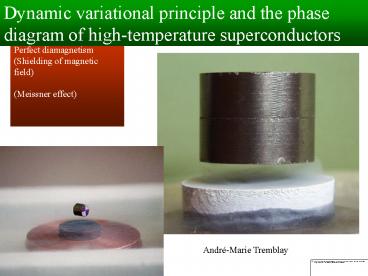Two ways to destroy a Fermi liquid PowerPoint PPT Presentation
Title: Two ways to destroy a Fermi liquid
1
Dynamic variational principle and the phase
diagram of high-temperature superconductors
André-Marie Tremblay
2
Some basic Solid State Physics non-interacting
electrons
3
Electronic states in d2
Angle Resolved Photoemission Spectroscopy (ARPES)
4
The non-interacting case
EDC
Damascelli, Shen, Hussain, RMP 75, 473 (2003)
5
Electron-doped, non-interacting
MDC
6
Interacting case The Fermi liquid
A(k,w)f(w)
Damascelli, Shen, Hussain, RMP 75, 473 (2003)
7
A Fermi liquid in d 2
T-TiTe2
U / W 0.8
Perfetti, Grioni et al. Phys. Rev. B 64, 115102
(2001)
8
Destroying the Fermi liquid at half-fillingLatti
ce interactions
A-Long-range order
Introduce frustration
Will resist LRO until critical U
9
Destroying the Fermi liquid at half-fillingLatti
ce interactions
B-Strong on-site repulsion (Mott transition)
10
Question What happens away from n 1?
A- Long-Range Order (U large enough)
Hole pockets Still FL
B- Mott transition DMFT
If gapped, gapped everywhere
11
Two ways to destroy a Fermi liquid hole and
electron-doped cuprates.
- I. Introduction
- Fermi liquid
- II. Experimental results from cuprates model
- III. Strong and weak coupling pseudogap (CPT)
- IV. Weak coupling pseudogap (QMC,TPSC)
- V. d-wave superconductivity
- VI. Conclusion
12
CuO2 planes
YBa2Cu3O7-d
13
Phase diagram
n, electron density
Damascelli, Shen, Hussain, RMP 75, 473 (2003)
14
Fermi surface, electron-doped case
Armitage et al. PRL 87, 147003 88, 257001
15
Fermi surface, hole-doped case 10
16
The Hubbard model
17
Weak vs strong coupling, n1
T
w
U
w
U
Mott transition
U 1.5W (W 8t)
18
Question quantitative and qualitative
- How do we go from a Mott insulator to a conductor
as a function of doping? - Hot spots and pseudogaps in the Hubbard model
(like experiment) ? - Close to understood in e-doped case.
19
Two ways to destroy a Fermi liquid hole and
electron-doped cuprates.
- I. Introduction
- Fermi liquid
- II. Experimental results from the cuprates and
model - III. Strong and weak coupling pseudogap (CPT)
- IV. Weak coupling pseudogap (QMC,TPSC)
- V. d-wave superconductivity
- VI. Conclusion
PowerShow.com is a leading presentation sharing website. It has millions of presentations already uploaded and available with 1,000s more being uploaded by its users every day. Whatever your area of interest, here you’ll be able to find and view presentations you’ll love and possibly download. And, best of all, it is completely free and easy to use.
You might even have a presentation you’d like to share with others. If so, just upload it to PowerShow.com. We’ll convert it to an HTML5 slideshow that includes all the media types you’ve already added: audio, video, music, pictures, animations and transition effects. Then you can share it with your target audience as well as PowerShow.com’s millions of monthly visitors. And, again, it’s all free.
About the Developers
PowerShow.com is brought to you by CrystalGraphics, the award-winning developer and market-leading publisher of rich-media enhancement products for presentations. Our product offerings include millions of PowerPoint templates, diagrams, animated 3D characters and more.

